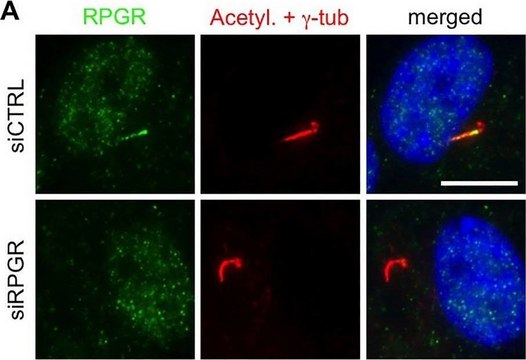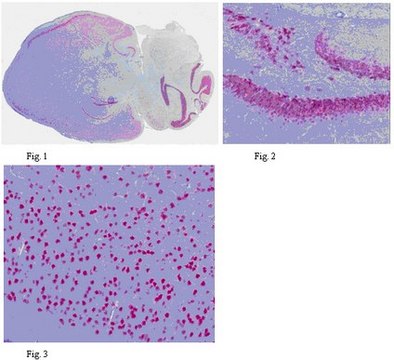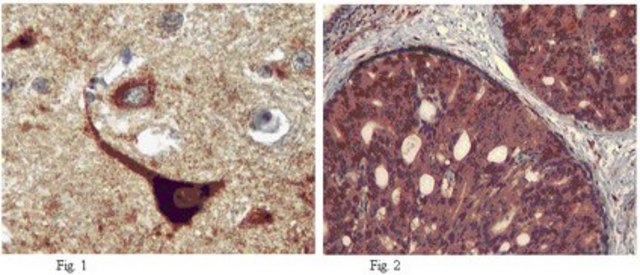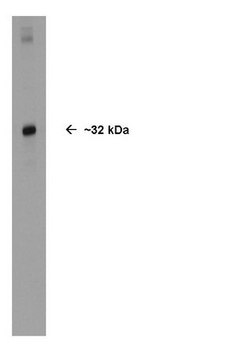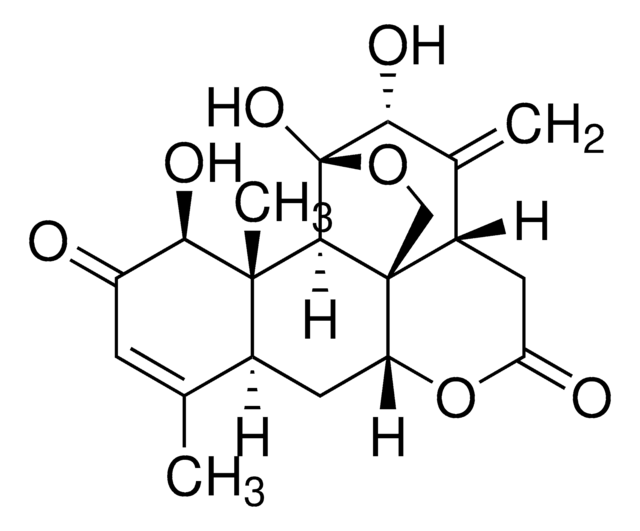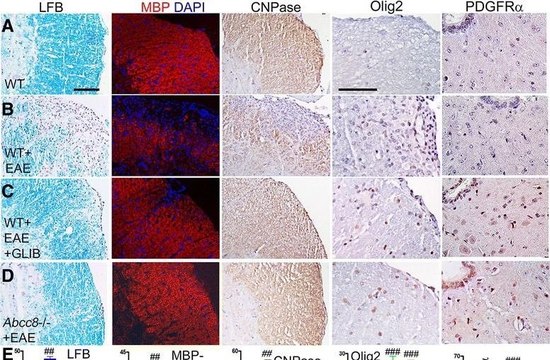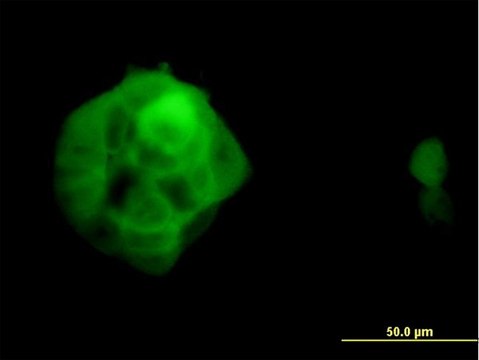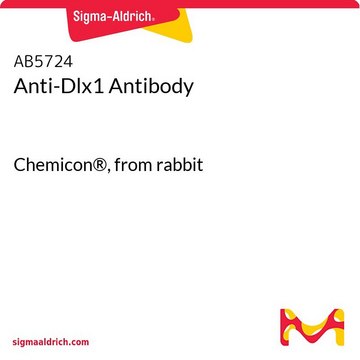推荐产品
生物来源
chicken
质量水平
抗体形式
affinity isolated antibody
抗体产品类型
primary antibodies
克隆
polyclonal
纯化方式
affinity chromatography
种属反应性
human, porcine, mouse
技术
western blot: suitable
同位素/亚型
IgY
NCBI登记号
UniProt登记号
运输
ambient
靶向翻译后修饰
unmodified
基因信息
mouse ... Crocc(230872)
一般描述
Rootletin (UniProt: Q8CJ40; also known as Ciliary rootlet coiled-coil protein) is encoded by the Crocc (also known as Kiaa0445) gene (Gene ID: 230872) in murine species. Rootletin is a major structural component of the ciliary rootlet, a cytoskeletal-like structure in ciliated cells that originates from the basal body at the proximal end of a cilium and extends proximally toward the cell nucleus. It contributes to centrosome cohesion before mitosis. In ciliated cells, it is associated with ciliary rootlets, but in non-ciliated cells it is localized between, around and at the proximal ends of the centrioles. It dissociates from the centrioles at the onset of mitosis and re-associates with them at anaphase. Highest expression of Rootletin is found in photoreceptor cells of retina. Lower expressions have been reported in brain, trachea and kidney. In retinal photoreceptors rootlets extend from the basal bodies to the synaptic terminals and anchor endoplasmic reticulum membranes along their length. During embryonic development, it is enriched along the apical domains of neuro epithelium in brain ventricular zone, in primordia of retinal pigment epithelia, and in neural retina. Rootletin contains a globular head domain and a tail domain that consists of extended coiled-coil structures. The head domain may be required for targeting to the basal body and binding to a kinesin light chain. (Ref.: Yang, J., et al. (2002). J. Cell Biol. 159(3): 431-440).
特异性
This chicken polyclonal antibody detects Rootletin in mouse retina. It targets an epitope within 188 amino acids from the C-terminal region.
免疫原
His-tagged recombinant fragment corresponding to 188 amino acids from the C-terminal region of murine Rootletin.
应用
Anti-Rootletin Antibody, Cat. No. ABN1686, is a highly specific chicken polyclonal antibody that targets Rootletin and has been tested in Western Blotting.
Research Category
Neuroscience
Neuroscience
Western Blotting Analysis: A representative lot detected Rootletin in Western Blotting applications (Yang, J., et. al. (2002). J Cell Biol. 159(3):431-40).
Immunohistochemistry Analysis: A representative lot detected Rootletin in Immunohistochemistry applications (Yang, J., et. al. (2002). J Cell Biol. 159(3):431-40; Sun, X., etl al. (2016). Proc Natl Acad Sci USA. 113(21):E2925-34; Yadav, S.P., et. al. (2016). Development. 143(9):1491-501; Pawlyk, B.S., et. al. (2016). Gene Ther. 23(2):196-204; Sun X., et. al. (2012). Cilia. 1(1):21; Liu, X., et. al. (2007). Proc Antl Acad Sci USA. 104(11):4413-8; Bahe, S., et. al. (2005). J Cell Biol. 171(1):27-33; Yang, J., et. al. (2005). Mol Cell Biol. 25(10):4129-37; Hong, D.H, et. al. (2003). Invest Ophthalmol Vis Sci. 44(6):2413-21).
Immunohistochemistry Analysis: A representative lot detected Rootletin in Immunohistochemistry applications (Yang, J., et. al. (2002). J Cell Biol. 159(3):431-40; Sun, X., etl al. (2016). Proc Natl Acad Sci USA. 113(21):E2925-34; Yadav, S.P., et. al. (2016). Development. 143(9):1491-501; Pawlyk, B.S., et. al. (2016). Gene Ther. 23(2):196-204; Sun X., et. al. (2012). Cilia. 1(1):21; Liu, X., et. al. (2007). Proc Antl Acad Sci USA. 104(11):4413-8; Bahe, S., et. al. (2005). J Cell Biol. 171(1):27-33; Yang, J., et. al. (2005). Mol Cell Biol. 25(10):4129-37; Hong, D.H, et. al. (2003). Invest Ophthalmol Vis Sci. 44(6):2413-21).
质量
Evaluated by Western Blotting in mouse retina tissue lysate.
Western Blotting Analysis: A 1,000 dilution of this antibody detected Rootletin in 10 µg of mouse retina tissue lysate.
Western Blotting Analysis: A 1,000 dilution of this antibody detected Rootletin in 10 µg of mouse retina tissue lysate.
目标描述
~227 kDa observed; 226.95 kDa calculated. Uncharacterized bands may be observed in some lysate(s).
外形
Affinity Purified
Purified chicken polyclonal antibody in PBS with 50% glycerol and without azide.
储存及稳定性
Stable for 1 year at -20°C from date of receipt.
Handling Recommendations: Upon receipt and prior to removing the cap, centrifuge the vial and gently mix the solution. Aliquot into microcentrifuge tubes and store at -20°C. Avoid repeated freeze/thaw cycles, which may damage IgG and affect product performance.
Handling Recommendations: Upon receipt and prior to removing the cap, centrifuge the vial and gently mix the solution. Aliquot into microcentrifuge tubes and store at -20°C. Avoid repeated freeze/thaw cycles, which may damage IgG and affect product performance.
其他说明
Concentration: Please refer to lot specific datasheet.
免责声明
Unless otherwise stated in our catalog or other company documentation accompanying the product(s), our products are intended for research use only and are not to be used for any other purpose, which includes but is not limited to, unauthorized commercial uses, in vitro diagnostic uses, ex vivo or in vivo therapeutic uses or any type of consumption or application to humans or animals.
未找到合适的产品?
试试我们的产品选型工具.
储存分类代码
10 - Combustible liquids
WGK
WGK 2
Rachel E Turn et al.
Molecular biology of the cell, 32(8), 800-822 (2021-02-18)
ELMOD2 is a GTPase-activating protein with uniquely broad specificity for ARF family GTPases. We previously showed that it acts with ARL2 in mitochondrial fusion and microtubule stability and with ARF6 during cytokinesis. Mouse embryonic fibroblasts deleted for ELMOD2 also displayed
Ying Hsu et al.
PLoS genetics, 13(10), e1007057-e1007057 (2017-10-20)
Genetic mutations disrupting the structure and function of primary cilia cause various inherited retinal diseases in humans. Bardet-Biedl syndrome (BBS) is a genetically heterogeneous, pleiotropic ciliopathy characterized by retinal degeneration, obesity, postaxial polydactyly, intellectual disability, and genital and renal abnormalities.
Kristen N Haggerty et al.
PLoS biology, 22(1), e3002467-e3002467 (2024-01-08)
Photoreceptor cells in the vertebrate retina have a highly compartmentalized morphology for efficient phototransduction and vision. Rhodopsin, the visual pigment in rod photoreceptors, is densely packaged into the rod outer segment sensory cilium and continuously renewed through essential synthesis and
Skylar I Dewees et al.
Molecular biology of the cell, 33(4), ar33-ar33 (2022-02-24)
The ARF family of regulatory GTPases is ancient, with 16 members predicted to have been present in the last eukaryotic common ancestor. Our phylogenetic profiling of paralogues in diverse species identified four family members whose presence correlates with that of
Rachel E Turn et al.
Molecular biology of the cell, mbcE21090443-mbcE21090443 (2021-11-25)
ELMODs are a family of three mammalian paralogs that display GTPase activating protein (GAP) activity towards a uniquely broad array of ADP-ribosylation factor (ARF) family GTPases that includes ARF-like (ARL) proteins. ELMODs are ubiquitously expressed in mammalian tissues, highly conserved
我们的科学家团队拥有各种研究领域经验,包括生命科学、材料科学、化学合成、色谱、分析及许多其他领域.
联系技术服务部门
